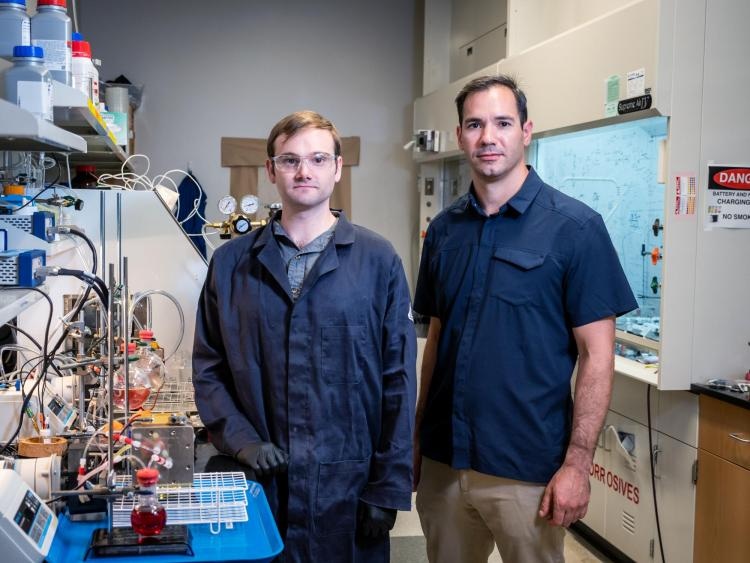Jul 29 2019
Economical, high-performance battery chemistry developed by CU Boulder scientists could someday result in scalable grid-level storage for solar and wind energy that could help electrical utilities to minimize their reliance on fossil fuels.
 CU Boulder PhD student Brian Robb (left) and Assistant Professor Michael Marshak. (Image credit: Patrick Campbell/CU Boulder)
CU Boulder PhD student Brian Robb (left) and Assistant Professor Michael Marshak. (Image credit: Patrick Campbell/CU Boulder)
The new breakthrough, reported on July 26th, 2019, in the journal Joule, delineates two aqueous flow batteries, also called redox flow batteries, in which chromium and organic binding agents are used to realize outstanding voltage and high efficiencies. The components are available in nature in large quantities, providing future promise for cost-effective manufacturing.
We’re excited to report some of highest performing battery chemistries ever, beyond previous limits. The materials are low-cost, non-toxic and readily available.
Michael Marshak, Study Senior Author and Assistant Professor, Department of Chemistry, CU Boulder
Renewable energy sources offer an increasing share of U.S. electrical production, but presently, they do not have a large-scale solution for storing harvested energy and reusing it to fulfill the requirements when the sun does not shine and the wind does not blow.
“There are mismatches between supply and demand on the energy grid during the day,” stated Marshak, who is also a fellow in the Renewable and Sustainable Energy Institute (RASEI).
The sun might meet the grid’s needs in the morning, but demand tends to peak in the late afternoon and continue into the evening after the sun has set. Right now, utility companies have to fill that gap by quickly revving up their coal and natural gas production, just like you’d take a car from zero to sixty.
Michael Marshak, Study Senior Author and Assistant Professor, Department of Chemistry, CU Boulder
While lithium-ion technology can supply power for smaller scale applications, millions of batteries would be required to support even a small fossil fuel power plant for an hour, stated Marshak. Although the lithium-ion chemistry is efficient, it is unsuitable to satisfy the capacity of a whole wind turbine field or solar panel array.
“The basic problem with lithium-ion batteries is that they don’t scale very well,” Marshak stated. “The more solid material you add, the more resistance you add and then all of the other components need to increase in tandem. So in essence, if you want twice the energy, you need to build twice the batteries and that’s just not cost-effective when you’re talking about this many megawatt-hours.”
Flow batteries have been recognized as a more potent approach. In aqueous batteries, the active ingredients are kept separately in liquid form in large tanks, which enable the system to distribute energy in an organized manner, just how a gas tank offers steady fuel combustion to a car’s engine when the pedal is pressed.
Although there are a few cases of flow batteries working reliably for decades (such as in Japan), they have battled to achieve a broad grip in municipal and commercial operations partly because of their bulky size, relatively low voltage, and high operating costs.
“The size is less of an issue for grid-scale systems because it would just be attached to an already large structure,” Marshak stated. “What matters is cost, and that’s what we wanted to improve on.”
The scientists returned to basics, re-investigating flow battery chemistries that had been explored years ago, but forsaken. The solution turned out to be mixing organic binding agents, or chelates, with chromium ions for stabilizing a powerful electrolyte.
Some people have taken this approach before, but hadn’t paid enough attention to the binding agents. You need to tailor the chelate for the metal ion and we did a lot of work finding the right one that would bind them tightly.
Brian Robb, Doctoral Student, Department of Chemical and Biological Engineering (CHBE), University of Colorado Boulder
Robb is also the lead author of the new study.
Marshak, Robb, and undergraduate researcher Jason Farrell tailored a chelate called PDTA, which forms a “shield” around the chromium electron, blocking water from obstructing the reactant and permitting one of the battery cells to disperse 2.13 V—almost twice the operational average for a flow battery.
PDTA is a by-product of EDTA, an agent already employed in some food preservatives, hand soap, and municipal water treatments because of its bacteria-stymying properties. EDTA is regarded as non-toxic. Additionally, the chemistry uses the benign type of chromium, the same form employed in stainless steel surgical instruments.
“We got this to work at the relatively neutral pH of 9, unlike other batteries which use highly corrosive acid that’s difficult to work with and difficult to dispose of responsibly,” Robb stated. “This is more akin to laundry detergent.”
“You could order 15 tons of these materials tomorrow if you wanted, because there are existing factories already producing them,” Marshak added.
A patent has been filed by Marshak and Robb on the innovation with help from Venture Partners at CU Boulder. They intend to continue optimizing the system, such as scaling it up in the lab for cycling the battery for more extended periods of time.
“We’ve solved the problem on a fundamental level,” Marshak stated. “Now there are a lot of things we can try in order to keep pushing the performance limit.”